Thursday, 20 October 2016
The Half Male Half Female Animals
Gynandromorphs are creatures split down the middle into male and female halves. Though most commonly found in insects and arachnids (spiders), the curious condition has been noted in higher animals including crustaceans, crabs, cardinals and chickens.It's unheard of in humans and it's thought that it occurs differently in each of the groups listed above.
The cause of this phenomenon is typically, but not always, an event in mitosis during early development. While the organism is only a few cells large, one of the dividing cells does not split its sex chromosomes typically. This leads to one of the two cells having sex chromosomes that cause male development and the other cell having chromosomes that cause female development. For example, an XY cell undergoing mitosis duplicates its chromosomes, becoming XXYY. Usually this cell would divide into two XY cells, but in rare occasions the cell may divide into an X cell and an XYY cell. If this happens early in development, then a large portion of the cells are X and a large portion are XYY. Since X and XYY dictate different sexes, the organism has tissue that is female and tissue that is male.
Gynandromorph Butterfly

Butterflies are among the most frequently noticed gynandromorphs, owing to the creatures’ oft-exaggerated sexual dimorphism – that is, male and female butterflies of the same species can differ greatly in both size and coloration.
Gynandromorph Moth
Moths can be afflicted by gynandromorphism to the same degree as butterflies but being primarily night-active insects, coloration plays a lesser role in display and identification. That leaves size, which isn’t good news if you’re a gynandromorphic moth. These bizarre creatures can also be identified by their antennae: those of males are feathery, those of females are slender.
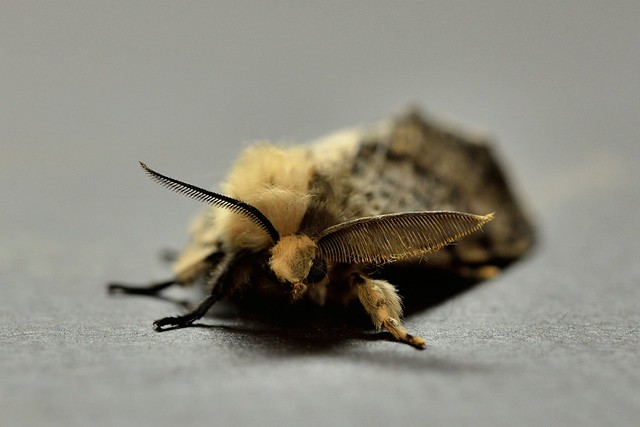 |
| These creatures can also be identified by their antennae |

It’s doubtful gynandromorphic moths of species that normally express a wide variance of sexual dimorphism can fly at all, so we must assume that most if not all of the recorded, documented and photographed examples emerged from their cocoons in captivity.
Gynandromorph Phasmid

Phasmids, like the gynandromorphic Malayan Jungle Nymph (Heteropteryx dilatata) above, are insects known variously as Walking Sticks or Leaf Insects after the inanimate objects they unconsciously imitate. The phasmid pictured is quite a piece of work since female Malayan Jungle Nymphs are much larger than males (and these insects are HUGE to begin with!), are colored bright lime green as opposed to mottled brown, and are flightless whereas males can fly.
Gynandromorph Spider
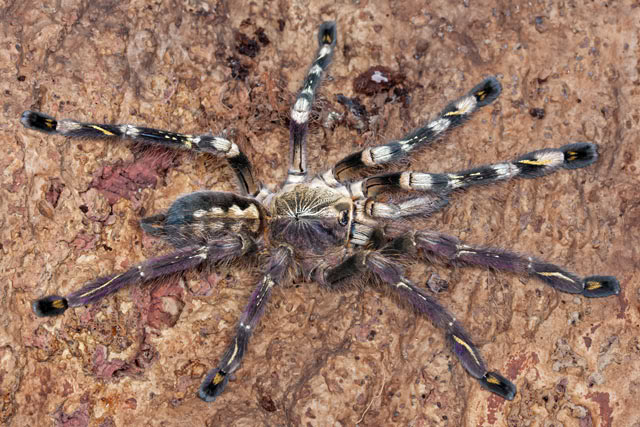
Aren’t spiders creepy enough without adding gynandromorphism to the mix? Actually, arachnids aren’t creepy at all – it’s all in your head, or ON your head if you don’t watch where you’re going! Spiders don’t exhibit as much sexual dimorphism as some insects (and spiders aren’t insects, trivia buffs) but gynandromorphs are still quite obvious even without an up-close-and-personal inspection.
Gynandromorph Crab
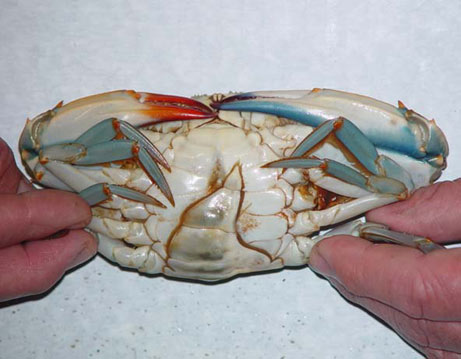
One claw two claw red claw blue claw…now hold on a sec, Blue Crab males have blue claws while Blue Crab females have red claws. What to make of a Blue Crab with one blue claw and one red claw, like the one caught by waterman Dave Johnson (above) in a crab pot off the coast of Gwynn’s Island, Virginia [USA] on May 21st of 2005? According to Virginia Institute of Marine Science crab expert Rom Lipcius, the crab Johnson caught is a bilateral gynandromorph, meaning it’s split down the middle gender-wise. Lipcius had never seen such a crab before but upon researching the topic came across a similar crab caught near Smith’s Island in 1979.
Gynandromorph Lobster
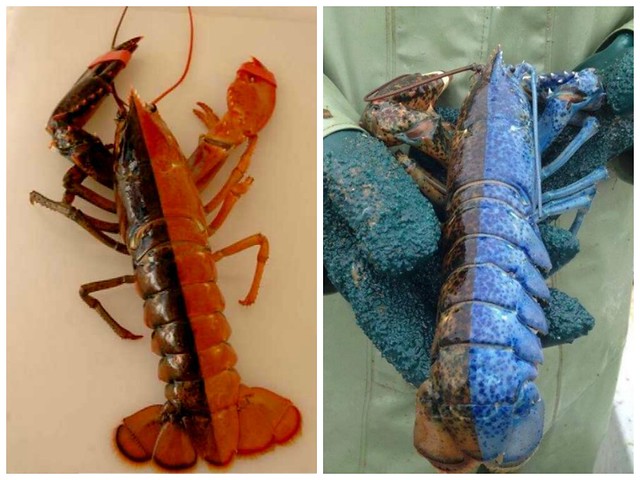
First noted in 1730, gynandromorph lobsters are extremely rare – they do attract notice, however, because the condition is often (but not always) characterized and/or accompanied by the male and female halves sporting different colors. Another way to quickly discern a gynandromorph lobster is to check its claws: American Lobsters normally possess one sharp cutting claw and one larger, blunter, crushing claw.
Female lobsters produce eggs whether they’ve mated or not; a gynandromorph lobster was once captured in the wild carrying half the usual complement of eggs. The lobsterman who found the creature donated it to the Maine Department of Marine Resources who monitored the eggs. Though only two eggs were observed to hatch, one of the larvae was male and the other was female.
Gynandromorph Chicken

Gynandromorphism has been observed in birds but not reptiles or amphibians – this may be due to the fact that normal male and female birds are often easy to tell apart, frogs & snakes not so much. Being domestic birds which demonstrate a wide degree of sexual dimorphism,gynandromorph chickens have been documented on numerous occasions throughout history.
A gynandromorph chicken looks lopsided due to the differing structure of muscle mass in hens and roosters. As well, the average gynandromorph chicken will typically have a spur on the male half’s foot but not on the female half’s foot. Do gynandromorph chickens crow with the sunrise? Maybe just a little… we can forgive them for going off half cocked.
Gynandromorph Cardinal
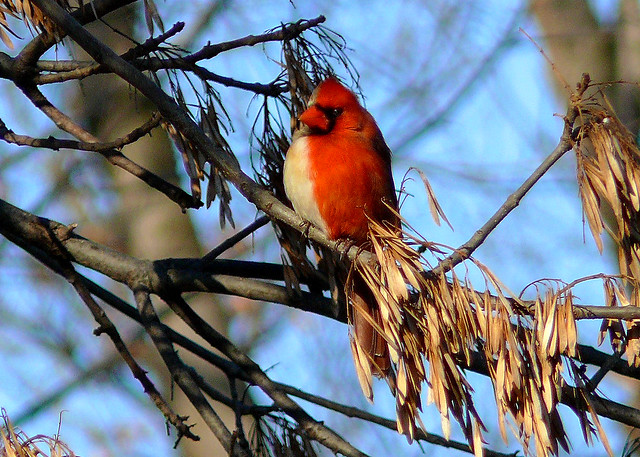
The Northern Cardinal is one of more common and colorful birds of North America. They also exhibit a high degree of sexual dimorphism – males and females are roughly similar in size but males are bright red from beak to tail while females display a much more muted feather color pattern.
Gynandromorph Cardinals are very obvious and even though they’re rare, those with bird feeders in their yards may notice one every once in a while. That is, if the bird’s facing towards the viewer or away: from the side it’s a different story. Other bird species that have exhibited gynandromorphism include songbirds such as Sparrows and Blue-throated Warblers but when it comes to striking displays of gynandromorphism, the Northern Cardinal rules the roost!
_____________________________________________________________________
Gynandromorphism is virtually unknown in animals higher than birds. Scientists think this is because in mammals, sexual differentiation occurs as a result of hormonal stimulus. In gynandromorphs, on the other hand, the condition occurs soon after an egg is fertilized and, on occasion, even before when two sperm cells penetrate an unfertilized egg. So-called “human gynandromorphs” such as that depicted in the 16th century woodcut above may merely be hermaphrodites – a whole ‘nother kettle of fish as it were! Can you imagine a human gynandromorph with different colored eyes and hair on either half? Aside of a cosplay convention or Comicon event, neither can we!
Subscribe to:
Post Comments (Atom)







No comments:
Post a Comment